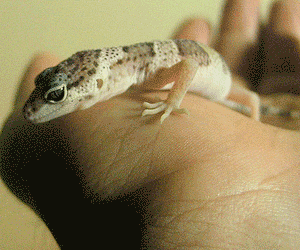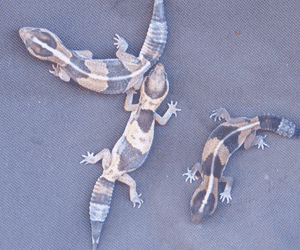[ad#300]
Gecko Time has always been about those who love geckos. Recently we’ve seen a rise in questions from our readers, and we love it. As readers have sent questions we had a brilliant idea. Why not take those questions, compile them, and have breeders answer them on the blog. This allows not only the person who submitted the question to gain the knowledge they were seeking but also informs our other readers who may have the same questions.
And so is born our Readers’ Question Answered series! Each month we will assemble a list of questions from our readers and have them answered. You can submit your questions on the Contact page. Here is the first round of questions from our readers answered by amazing breeders:
[ad#sponsor]
Question 1:

I just came across your blog after doing a Google search for geckos. My 12 year old son wants very much to get a leopard gecko. Must we have a ready supply of live crickets or is there prepared “gecko food” available in stores? Also, can geckos be handled or is there a risk of losing them?
Frank McGowan responds: The Leopard Gecko is primarily an insectivore. In captivity a healthy, varied diet for a Leopard Gecko could consist of several of the following prey items: crickets, mealworms, superworms, waxworms, and various species of small roaches. There are other items that can be used, but most Leopard Gecko Breeders use one or two of the listed feeders, typically crickets and /or mealworms, as staple items and occasionally offer the others for variation. It is important to have food items such as these on hand when or immediately after you acquire the Leopard Gecko as they will require food several times a week. The frequency and amount of food items provided will depend largely on the gecko’s size and age. It is also important to note that most feeder insects need to be gut-loaded and frequently supplemented with vitamin powder to ensure your Gecko is getting a nutritious meal.
Leopard Geckos on average are as tolerant of frequent handling as almost any reptile pet available and although hatchlings can be quick and excitable, there is not a significant risk of losing a juvenile, sub-adult, or adult Leopard Gecko when handling them. It is important to learn the proper way to handle them prior to doing so, but the most important thing to avoid is picking the gecko up by its tail. The Leopard Gecko can drop its tail when mishandled or threatened and when it regenerates, it is rarely as attractive or as long as the original tail.
Melody and Keith Venatta respond: Leopard Geckos can make great pets for responsible children. They can be very easy to handle and are rarely aggressive. Generally, the younger the gecko is the more jumpy it will be. Usually adult geckos are more mellow. This is a good thing to think about when selecting your new pet. Kids seem to be drawn to babies but they can be more difficult to handle. They’re very fast and jumpy! Regardless of the age of the gecko, it’s a good rule to handle them over their tank or table or sitting on the floor just in case they do take a flying leap. They can be seriously injured if they take a long fall onto a hard floor.
All Leopard Geckos require live food items. There are freeze dried products on the market but I’ve never seen a gecko even taste them and they really do not supply adequate nutrition. There are quite a few choices for feeders though. Crickets are probably the most readily available at all pet stores. Most people hate them because they make noise but if you can find younger crickets that don’t have their adult wings yet noise won’t be an issue. Mealworms can be obtained at many pet stores and can be kept in the refrigerator. Superworms are also a good choice and should be kept at room temperature. Other options include various roach species, silk worms, and hornworms. Most pet stores carry wax worms but these should not be used as a staple food item as they have a very hight fat to protein ratio. All of these food items can be ordered online and shipped to your door.
Question 2:

I have a leopard gecko that I absolutely love. This gecko has bought me into the “Reptile Spell”. This is making me want to get more and more geckos! So I have narrowed it down to Crested Geckos and African Fat Tailed Geckos. My question is which is more fun to care for and does not require as much money on monthly expenses.
Frank McGowan responds: New Caledonia, gets my vote. I enjoy the Crested Gecko for several reasons. They are available in a variety of colors and patterns. They can be raised individually or in a group, provided only one male is in each group. They are successfully raised on a commercially available powder diet that only needs to be mixed with water to create a paste that replicates the nectar they feed on in their native habitat. They do enjoy occasional crickets; the number of insects to be provided is greatly reduced from the number required for a Leopard or Fat Tail Gecko. They are nocturnal like the other two geckos, however, they thrive at temperatures ranging between 70 and 83 degrees and do not require the higher ground temperatures of the others. They are excellent climbers, and they tend to fare better in taller enclosures. Crested Geckos also require daily misting to provide the humidity they require to simulate their natural habitat but this is only a minor trade-off for the joy they can provide as a pet.
Melody and Keith Venatta respond: I think that where you live makes a difference in deciding whether Cresteds or AFTs are easier to keep.
If you live in a moderate climate and have a way to heat and cool the room your geckos will be in then Crested geckos can be a great choice. They like to be around room temperature so they don’t usually require any special heating or lighting equipment. They cannot stay at temperatures over 80F for very long though. If you do not have air conditioning and there’s a heat wave they could perish so this is something you need to consider. One of the great things about them is that they can live solely on Crested Gecko Diet, a powdered diet that you mix with water. They are arboreal geckos so they need more height that floor space and they should be misted daily. If you’re a fan of a naturalistic vivarium there are lots of live plants you can put in the tank.
Fat Tails require care that’s more similar to Leopard geckos. They need more humidity but will typically eat the same types of feeders (some prefer crickets) and live in the same sized enclosures. If you already keep your Leopard geckos in a rack system and have extra tubs available then Fat Tails may be an easier addition.
They’re both very different but are fairly equal in set up cost and amount of care required so I think it should really come down to personal choice. Pick whichever one you’re more interested in!
[ad#sponsor]
Thanks to our experts for answering!
The following folks were kind enough to answer our visitor’s questions. Here is a bit more about Frank McGowan and Keith and Melody Vanetta:
Frank McGowan of Frank’s Geckos has been actively keeping various reptile species for over 30 years. Some of the species he has had in his collection include Leopard Geckos, Crested Geckos, Giant Day Geckos, Blue Tongue Skinks, Ball Pythons, Honduran Milk Snakes, Corn Snakes, Eastern Box Turtles, Eastern Garter Snakes, Alligator Snapping Turtles and Diamondback Water Snakes. He began actively breeding Leopard Geckos in 2003 and formed Frank’s Geckos with his wife Linda, in 2004. Frank has worked with many Leopard Gecko morphs over the years and continues to do so to this day. Frank’s Geckos began breeding Crested Geckos as well in 2007. Frank believes some of his future projects could include one or more other species of the Rhacodactylus family and possibly some work with species in the Uroplatus family. Frank’s Geckos operates out of central New Jersey and is a regular vendor at the NY Metropolitan Reptile Expo in White Plains, NY. For more information, please visit www.franksgeckos.com.
Keith and Melody Venatta have been keeping reptiles 20+ years collectively but started focusing on geckos exclusively in 2005. We’re currently working on Leopard, Crested, and Fat Tail gecko projects and are excited about getting to work with our first group of Knob Tails this year. www.concretejunglegeckos.com


there is a massive buying of geckos in southern philippines, fetching as much as a Thousand Dollars to geckos reaching 3.2 grams. is this situation true what uses does the creature have making its price higher.the buyers are allegedly from malaysia.. is this peasible???
I would have to disagree. I’ve owned both fat tails and cresteds and fat tails are a lot better for handling. 😛